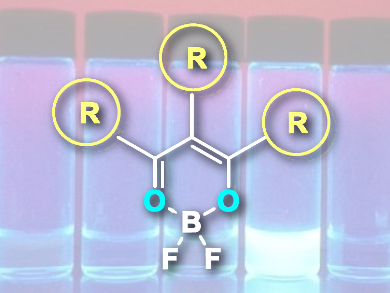Aggregation-induced emission (AIE) luminophores are a unique class of dyes. In solution, they are characterized by weak emission intensities and low quantum yields, which greatly improve in the solid state or in poor solvents in response to molecular aggregation. Typically, such behavior is observed for branched non-planar molecules and is associated with the aggregation-triggered restriction of intramolecular motion, which is one of the main causes of non-radiative decay in dissolved state.
Vsevolod Peshkov, Soochow University, Suzhou, China, and colleagues have synthesized a series of O,O-chelated boron complexes that were prepared through a four-component Ugi reaction, followed by complexation of the resulting 1,3-dicarbonyl compounds with boron trifluoride diethyl etherate. In most of the studied cases, both the Ugi reaction and the boron complexation proceeded smoothly, allowing the team to obtain Ugi adducts and the corresponding boron complexes in good yields.
A study on the optical properties of these luminophores revealed their pronounced AIE features. The photoluminescence quantum yields for the solid samples were observed in the range of 0.80–1.00, placing them among the most efficient boron-based luminophores.
- Boron Complexes of Glyoxal-Derived Ugi Adducts as a New Class of Photoluminescent Materials Featuring Aggregation-Induced Emission,
Huiping Wei, Gaigai Wang, Yingchun Wang, Binbin Li, Jianjun Huang, Stepan Kashtanov, Kristof Van Hecke, Olga P. Pereshivko, Vsevolod A. Peshkov,
Chem. Asian J. 2017.
DOI: 10.1002/asia.201700051



